The best methods for limiting costly surface patching
May 12, 2023
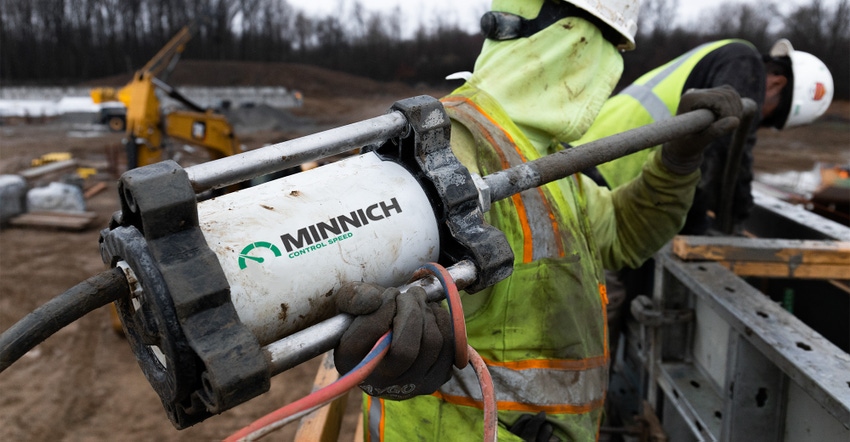
The past few years have spurred an increase in concrete vibration studies, research and greater funding to continue examining the issues caused by vibrator and concrete mix incompatibility. Studies have shown that over-vibration of any level of concrete leads to several issues, but the solution has not changed since the first American Concrete Institute (ACI) 309 Consolidation Guide was produced and published. The solution is the workability of concrete should be matched to the energy (frequency) output of the vibrator, regardless of the vibrator brand.
Keep in mind that a concrete vibrator is a vital part of a workability system that begins with mix design and must react to concrete variability during the batching, transport, pumping and placement portions of the process. Vibration is used to remove unwanted macro air (> 1mm) and leave the concrete in the state intended upon mix design. The more workable the concrete, the more control of vibrator frequency is needed, especially in pumpable and near-flowable concrete mixtures.
Pavement Research Leads to Application of Vibration Science
The Federal Highway Administration and Individual State Highway Agencies applied research dollars to analyze the effects of vibration on concrete pavement. From lab research, Controlled Frequency Vibration (CFV) systems were developed to limit vibrator frequency, and prevent the damage caused to concrete pavement surfaces when high-frequency vibration is used for consolidation. The researched pavement vibration specifications were adopted by individual state Departments of Transportation.
The vibration energy knowledge that was developed from road construction studies was then used to examine the issues with concrete structural surfaces in vertical/commercial concrete pours. That brings us to the present day and the application of vibration science that was derived from pavement research. Field study procedures have been developed and from these pre-construction trials, vibrator frequency recommendations were lowered from 13,000 – 17,000 vpm to a compatible range of 6,000 – 10,500 vpm. This change reduced the occurrence of driving available mix water of pumpable and near-flowable mixes to the surface of the concrete forms. These unwanted blemishes become visible on the form surface of freshly placed concrete. They are routinely misidentified by vibrator operators as air voids from under-vibration when instead, they could be easily avoided.
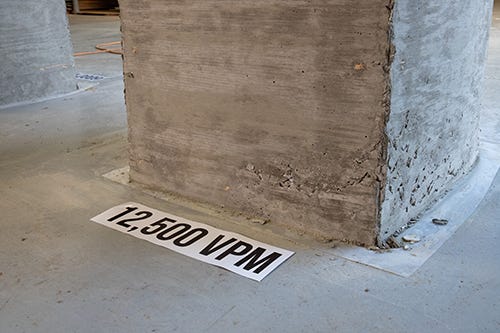
Although not every type of material separation can be traced to vibrator frequency alone, that’s not universally understood by the end user in the concrete industry. Generally, the laborer’s impression of all vibrators is that the tools produce the same energy regardless of the type or make. This is untrue and makes it difficult to educate laborers on concrete viscosity versus vibrator frequency compatibility. Now, thanks to research, simplified and easily digestible vibrator energy wave concepts are used in clinical analysis. These concepts will also be used in the future to help users understand the predictive behavior of both vibrator and concrete variability tendencies.
Now, there are several field trials that can be conducted by contractors to find the right amount of vibration energy at pre-construction to make the final construction outcome more predictive. The participating contractor will prepare several wooden boxes to test the concrete when they are pouring their mock-up forms before actual construction. The method used is quite simple and a more cost-effective way to limit the expense and time spent patching a structure’s surface.
Pre-Construction Vibration Frequency Compatibility Testing
The usual choice of a contractor’s quality control department is the construction of several wooden boxes that are built as 24-inch cubes (see Figure 1). During the pre-construction stage, the boxes are filled with concrete mix, consolidated as set vibrator frequencies, and then analyzed the day after for evaluation of surface issues.
Figure 1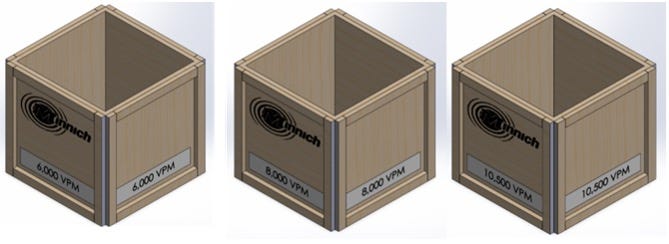
The boxes are constructed, the joints remain unsealed, and the box surfaces are applied with releasing agent. The trial boxes are marked by the vibrator frequency (vpm) that the contractor selects. Normal trial frequencies are 10,500, 8,000 and 6,000 vpm.
Box 1 is filled with concrete mixture that will be used for the intended job. Once filled, the wooden box top is screed off to level. No form of consolidating the concrete is used.
Box 2 is filled with concrete mixture. The concrete vibrator that will be used during actual construction is inserted and vibrated at a predetermined frequency (vpm) for a total of three seconds. (see Figure 2)
Figure 2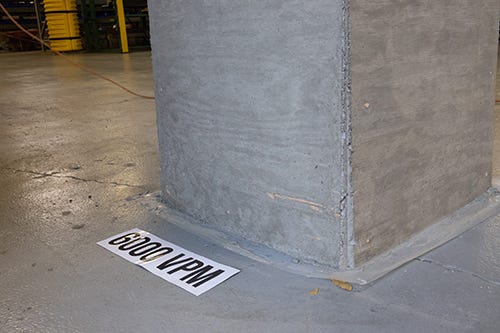
Note: There are a few types of controlled frequency vibrators that can be used. A gas-powered vibrator that can be set and monitored by a tachometer; a hydraulic vibrator that can be set and monitored by a paving machine; a high-cycle vibrator that runs from a frequency conversion box; a controlled frequency 60 cycle motor driven flex-shaft that can be set and monitored by your cell phone or tablet device.
Repeat steps using a different vibrator frequency for box 3.
When the concrete is poured and vibrated for three seconds, a measuring tape can be used to calculate the volume of the air entrapment that occurred during the trial. The trial boxes should be close to the same calculated volume. Beware of the amount of water that is forced through the form’s joints because that also reduces the amount of volume of concrete poured into the trial box.
Allow the boxes to cure, then strip the wooden forms. A contractor can decide which trial frequency was most effective in consolidation based on the visible surface blemishes and bug holes.
Method Reminders: Several factors can change the results. The main factor is that there is variability in the batching or transport process. The most significant is slump differential from the variances in concrete material moisture levels (explained below). This can be confusing for a first-time user of this pre-construction trial method. The delivered slump variation, or bleed water, content can throw off what you expect, but when quality control gets acquainted with the trials it shows the variability in the delivered concrete on-site during the job.
Researchers are working on quality control tests that can add more learning data for contractors on the mixture's bleed tendency or the change from slump variance. The work will help develop an easy, accurate and repeatable workability meter to dial in on concrete variances and how they will affect concrete construction. The handy and simple slump cone test that was introduced and accepted in the 1920s will give way to more accurate measuring tools. This test will be a better measurement of more rheological properties, which will help in a more predictive concrete placement experience.
Use of a Controlled Frequency Vibrator (CFV)
If you are using a CFV and evaluating vibration curves as a source of controlling batching or transporting variances, you can receive help in understanding the data that is being logged by the manufacturer. In collecting job electronic data, the CFV will report a curve that can be compared to the curve that is reported at pre-construction trials (see Figure 3). The contractor can take a log for each truck that is delivered to the jobsite by dipping a vibrator into the concrete for three seconds before vibration.
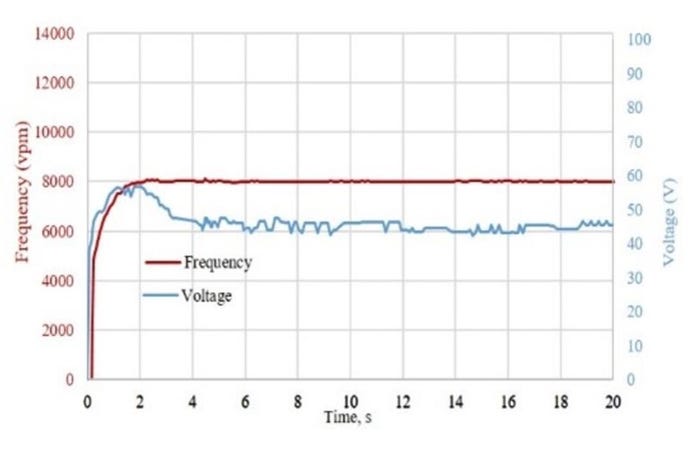
The research will be ongoing to link an accurate digital slump reading to the curve that is generated by a CFV in the “not so distant” future of construction practices that can be linked to the rest of the job concrete placement loggings. It’s important to note that the variety of industry concrete vibrators all act differently against concrete loads, and to limit patching needs, vibration control and evaluation are the first steps in a predictive outcome. Vibration compatibility testing should be done in pre-construction trials, and you should always get help from the manufacturer of the trial vibrator.
Proper concrete consolidation ensures a strong, long-lasting and attractive outcome. To achieve the desired results though, the effects of vibration on the mix need to be understood. For further questions regarding concrete vibration, reach out to the Minnich Manufacturing team. They’re true experts and are happy to talk with you about how Minnich products can integrate seamlessly into your operation.
You May Also Like



